
 |
|
|
#1 |
|
Member
Join Date: Dec 2004
Posts: 987
|
Here is an interesting example of the fusion between daab and nihon-to that was popular during the middle and late Ayutthaya Period. According to Khun Nattapat, Director of Research at the Thai National Museum (interview by Dan Wilke), as the popularity of Japanese swords increased, the Monarch required that they must show a Thai influence (i.e., Thai decorative features and motifs). This resulted not only in katana blades mounted in a Thai style, but blades such as this, which are purely Thai in manufacture yet display a distinct Japanese flavor. The grip is done with a pattern that somewhat abstractly depicts the kind of silk cord wrapping found on nihon-to. The grabang (guard) is larger than is typical, more like a Japanese tsuba. The handle has a slightly oval cross-section, not round as is more typical for daab, yet not as much as found on nihon-to. It has a neat demon/ogre face on the pommel cap. Interestingly, the blade profile is remarkably like that of a Chinese liuwei dao. The scabbard, while well-make, is a later replacement. The original would likely have had metal fittings en suite with the handle decoration.
My guess is that this is an 18th C sword. |
|
|

|
|
|
#2 |
|
Arms Historian
Join Date: Dec 2004
Location: Route 66
Posts: 10,595
|
Beautiful example! and fascinating topic Mark.
I have often wondered how closely the swords of Asia cross influenced, and this is a great illustration. The blade does resemble the willow leaf, and it seems that at certain times there were great numbers of Japanese swords brought into China, which brought, among other features, the discoid guard. Those wavy lines seem to be an often seen motif on SE Asian swords. Is there any specific symbolism? All best regards, Jim |
|
|

|
|
|
#3 |
|
EAAF Staff
Join Date: Dec 2004
Location: Louisville, KY
Posts: 7,325
|
I agree - fascinating and lovely. I love the metal work on the handle.

|
|
|

|
|
|
#4 |
|
Member
Join Date: Jun 2006
Posts: 179
|
Really, really nice. Really.

|
|
|

|
|
|
#5 |
|
Member
Join Date: Dec 2004
Location: Oahu, Hawaii
Posts: 166
|
As Mark mentions there was quite the Japanese influence in Thailand. Should you get the chance check out the Grand Palace in Bangkok as you enter there is another section that will cost you few extra baht to enter, but well worth the investment. It house much of the Royal jewelry, arms and insignia. It was there through and interview with a guard that I learned about the different royal ranks and who could what (enamel, copper, silver, gold, jewels) on their accouterments. Apparently there were court rules that governed all of this - never did find a copy.
But you've got to stop by the armory - dha galore - and surprisingly keris also. But the one part that stuck in mind and has to do with what Mark is talking about here was a small sign near, what I thought was, a katana. Mentioned that in 1660 (I think) a Japanese merchant was elevated to the rank of Chao Praya (or one those ranks), the highest achieved by any foreigner after he raised 3000 troops (from within Thailand) to fight for the king in one of the wars. That along with the fact that the Japanese used to trade blades for Thai rayskin, the Prince's sword is a Thai katana and I'm thinking that qualifies as significant Japanese influence 
|
|
|

|
|
|
#6 |
|
Member
Join Date: Dec 2004
Location: Oahu, Hawaii
Posts: 166
|
BTW Mark I've only seen these in a museum and the one you have - keep a watchful eye on that one my brother.

|
|
|

|
|
|
#7 |
|
Member
Join Date: Aug 2007
Posts: 865
|
Stunning piece Mark! Thanks for sharing...I think many are drooling...I know I am...I especially like the imitation of the cord wrap on the handle...and the seal on the end!
Here are some pictures of some Thai -Japanese hybrids Puff posted a while back:  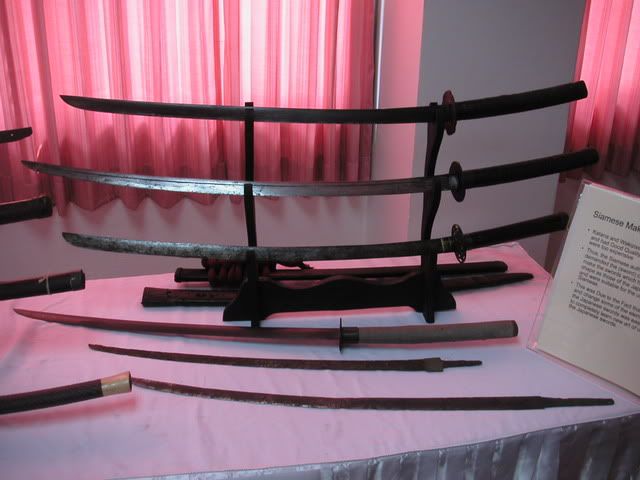
|
|
|

|
|
|
#8 |
|
Member
Join Date: Feb 2005
Location: England
Posts: 373
|
I wonder if one of the main influences for this style of sword in Siam/Thailand, didn't stem from when Yamada Nagamasa with 800 ronin helped bring order back into Thailand after the death of King Song Thom in 1628, very nice sword btw.
|
|
|

|
|
|
#9 |
|
Member
Join Date: Dec 2004
Location: What is still UK
Posts: 5,891
|
This is very attractive with pleasant repouse and chassing to the hilt, also a nice clean blade but what makes this piece 17th or 18th century? these items are not my main interest so it would be helpful if we could have some background information to oppinions made so far?
|
|
|

|
|
|
#10 |
|
Member
Join Date: Dec 2004
Location: Oahu, Hawaii
Posts: 166
|
sirupate, that me be the event I was trying to reference (should go back and check my notes) but the the timeframe and the names jogged a memory fragment loose when you mentioned it.
|
|
|

|
|
|
#11 | |
|
Member
Join Date: Dec 2004
Posts: 987
|
Quote:
|
|
|
|

|
|
|
#12 | |
|
Member
Join Date: Dec 2004
Posts: 987
|
Quote:
|
|
|
|

|
|
|
#13 | |
|
Member
Join Date: Dec 2004
Posts: 987
|
Quote:
|
|
|
|

|
|
|
#14 |
|
Member
Join Date: Aug 2007
Posts: 865
|
Mark/ Dan......I'm trying to remember...when was it that the Lao smiths where brought from Laos to Aranyik?
|
|
|

|
|
|
#15 |
|
Member
Join Date: Dec 2004
Location: Oahu, Hawaii
Posts: 166
|
Mark, no I never found anything concrete about the number of bands equating to rank, although if you put that thought in somebodies head, I've found that they'll sometimes agree with it. Can't tell if that's cause it jogged their memory or they just want to look intelligent.
I'll have to find notes Mark I'm pretty sure it was in the 1600s, but I still haven't found everything after the move from Japan Nathaniel, I'm unfamiliar with Lao smiths being brought to Aranyik. I do know that many LAO silver smiths were force migrated to Chiang Mai and Nakhon Sri Thammarat about the same time as Chiang Mai was repopulated. Dan |
|
|

|
|
|
#16 |
|
Member
Join Date: Aug 2007
Posts: 865
|
Dan,
Oh, yes, Aranyik smiths are actually from Laos originally... http://www.chiangmai-mail.com/087/tours.shtml "Ayutthaya province has also become known for its OTOP (One Tambon One Product) goods, such as handmade Aranyik swords and kitchenware. The swords are produced at Tahchang by people originally from Laos. “The Aranyik sword is a popular souvenir from Ayutthaya, while the popular tourist attractions are the local cultures and traditions, buildings, elephant riding, and bicycling to view Ayutthaya town,” he said." http://www.cozun.com/Aranyik.htm "Although the craftsmen origins are traceable back to Laotian ancestors from Vientiane, their skill and methods to work the sword materials incorporate several Japanese techniques." http://ilwc.aru.ac.th/Contents/ArtCr...tCraftEng2.htm "When talking about good quality knives, most Thai people think of “Aranyik knives” that are bought from Aranyik village in Tha Reu District, Ayutthaya . Few people know the truth that Ban Aranyik is not the place that produces Aranyik knives, but it is the name of the market and the gambling house. One of the most outstanding products is “Knives”. The villagers from Ban Pai Nong and Ban Ton Pho, Nakorn Laung District 2 kilometers south of Pa Sak River, are the makers who sell knives there. Because they are so sharp and good quality, knives bought from Ban Aranyik, are called “Aranyik Knives”. ....It is said that the ancestors of residents of the Bang Pai Nong and Ban Ton Pho were Vientians from Laos who moved to settle in Thailand during the reign of King Rama II. Most of them were blacksmiths. When they came here, they found a good location with a big swamp. Pa Sak River and the bamboo forest were the best main fuel to forge the heated iron and the bamboo could also be used as a handle for large hammers or a knives. So they settled there to have a career of forging knives and have been there ever since. " Last edited by Nathaniel; 22nd August 2009 at 05:40 AM. |
|
|

|
|
|
#17 |
|
Member
Join Date: Aug 2007
Posts: 865
|
Also some further reference pieces:
 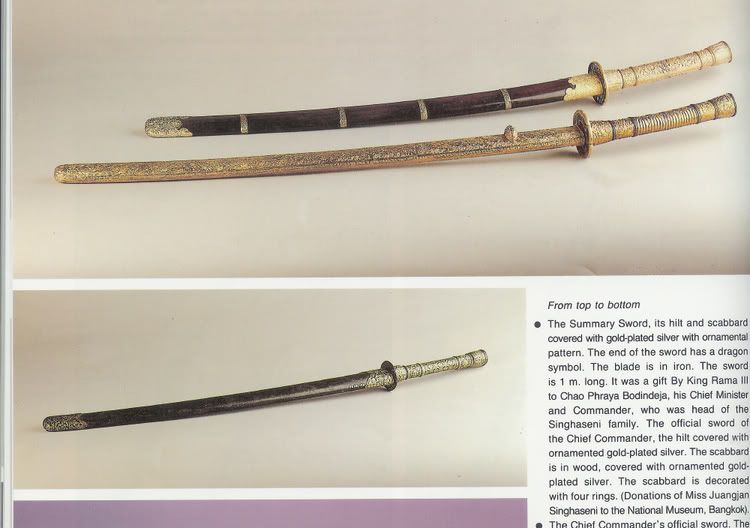
|
|
|

|
|
|
#18 |
|
Member
Join Date: Aug 2007
Location: CHRISTCHURCH NEW ZEALAND
Posts: 2,809
|
I have had this piece for a while now,and it came to me as being of Khmer or Cochin origin. Having seen the pics posted here, it at least looks as if the shape could be influenced by Japanese swords/blades. Condition is not wonderful but is certainly original.
The bamboo piece on the scabbard was there when I originally got this sword and I would be interested to know if anyone can shed any light on its meaning. Regards Stuart |
|
|

|
|
|
#19 |
|
Member
Join Date: Aug 2007
Posts: 865
|
Interesting piece Stu....I've seen more Lao, Cambodian and Vietnamese pieces with guards in kind of a Japanese/ European influence.
Here are some pictures of a sword on the wall at the Royal Barge Museum..it also has a guard: 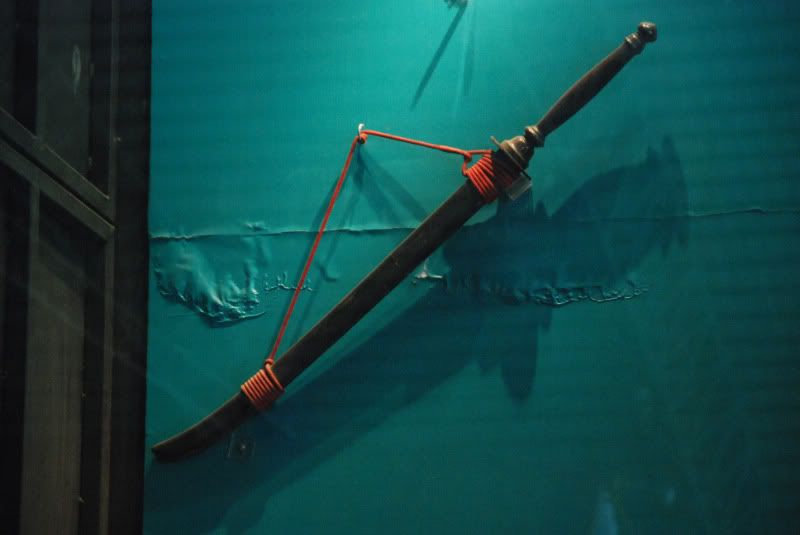 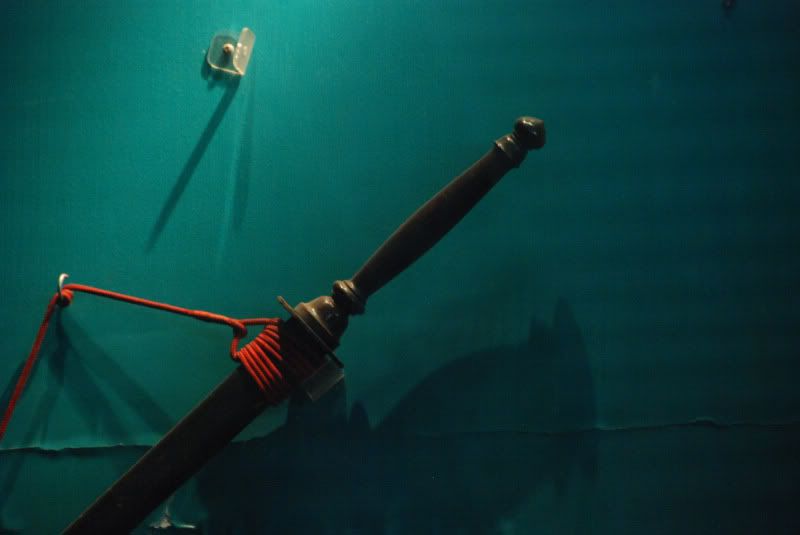  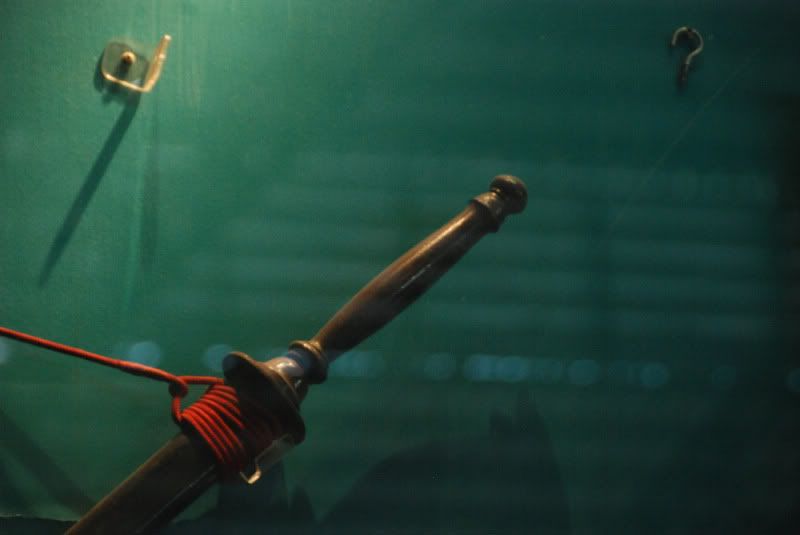
|
|
|

|
|
|
#20 |
|
Member
Join Date: Jun 2006
Posts: 179
|
For further referance. Here is some detail from a Daab in the style of top pic from the National Museum. Very similar wrap design to Mark's. Same oval cross-section as well. This one however, has a blade with a similar profile to that of the rattan-handled Daab in the same pic.
|
|
|

|
|
|
#21 |
|
Member
Join Date: Aug 2007
Posts: 865
|
DhaDha, That is a fantastic looking handle...I really have to see the National Museum...somehow I've never made it there yet.
It reminded me of a beautiful metro shan pieces listed on Mark's Dha Research Index...C0046   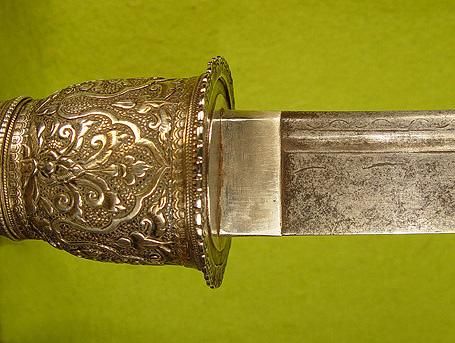 Japanese influence can be seen obviously with the habaki. |
|
|

|
|
|
#22 |
|
Member
Join Date: Feb 2005
Location: England
Posts: 373
|
Also the fuller looks very similar to the bo hi on Japanese swords
|
|
|

|
|
|
#23 |
|
Member
Join Date: Aug 2007
Posts: 865
|
I was waiting to see if anyone mentioned it...or the new owner to post....but I think I will just go ahead and reference ...funny how Mark shows us his piece and another shows up shortly after...
 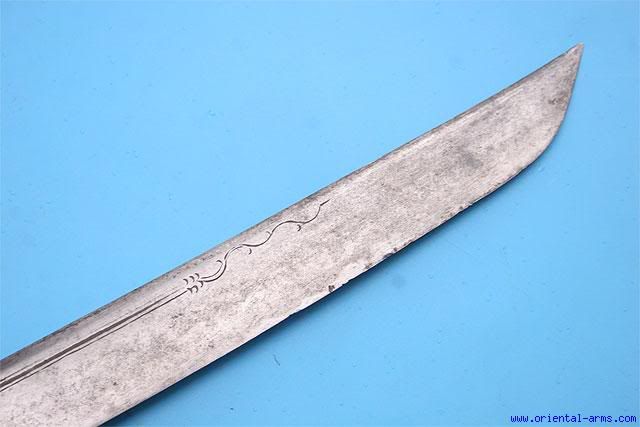 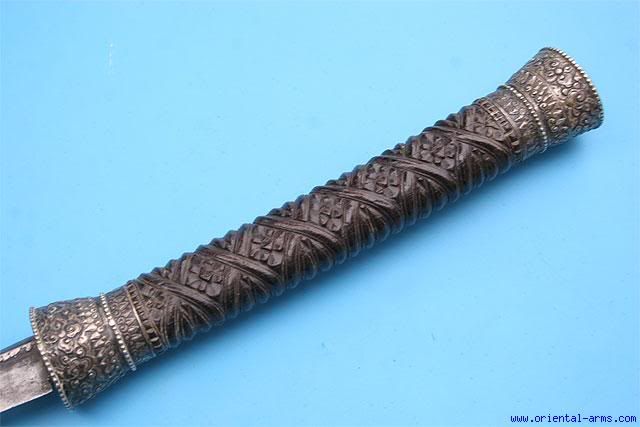 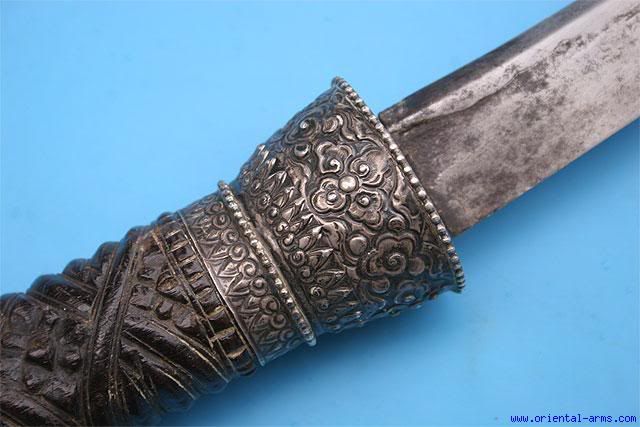 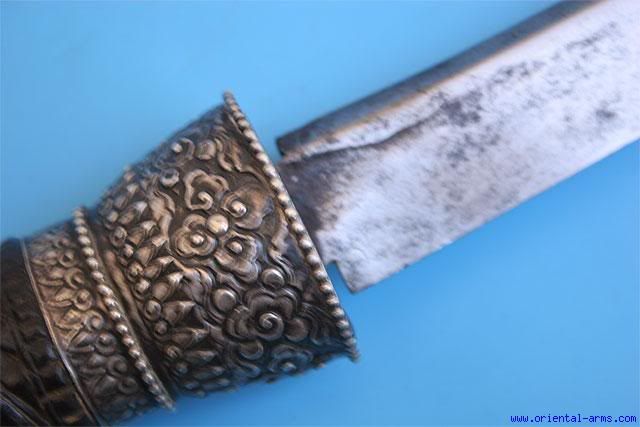 http://www.oriental-arms.com/item.php?id=3743 |
|
|

|
|
|
#24 | |
|
Member
Join Date: Dec 2004
Posts: 987
|
Quote:
|
|
|
|

|
|
|
#25 | |
|
Member
Join Date: Dec 2004
Posts: 987
|
Quote:
|
|
|
|

|
|
|
#26 |
|
Member
Join Date: Aug 2007
Posts: 865
|
Mark,
We forgot to cite a past thread you posted  http://www.vikingsword.com/vb/showth...ight=thai+daab |
|
|

|
|
|
#27 |
|
Member
Join Date: Dec 2004
Posts: 987
|
Of course! Thanks, Nathaniel.
 I still need to track down that one's "brother" in the National Archives. I still need to track down that one's "brother" in the National Archives.
|
|
|

|
|
|
#28 |
|
Member
Join Date: Jun 2006
Posts: 179
|
[QUOTE=Nathaniel] ...or the new owner to post....
Just arrived. I haven't had a good chance to really look at it yet. But at first glance, really nice, I think. Very well balanced. A good chance the blade is layered/laminated. 
|
|
|

|
|
|
#29 |
|
Member
Join Date: Aug 2007
Posts: 865
|
Oops, Sorry Shawn, I didn't mean to "jump the gun" with posting your new beauty...please post some pictures and your review once you get a chance to examine it more

|
|
|

|
|
|
#30 | |
|
Member
Join Date: Jun 2006
Posts: 179
|
Quote:
 No worries No worries  Glad you like it. Glad you like it.It is a beauty. |
|
|
|

|
 |
| Thread Tools | Search this Thread |
| Display Modes | |
|
|